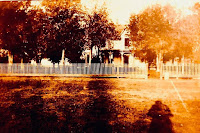 |
| William Z. Farris |
 |
| Nancy L. |
(1861-1891) on 19 Oct 1880 in Randolph County, MO. There, they settled on a farm.
 |
| Farris Farm, c. 1910 |
The couple had five daughters, the youngest of whom was Mary Louis Farris (her middle name Louis was after her grandfather Louis Bunnell).
After “Nannie Louise’s” death, William remained in contact with her relatives, hosting Bunnell-Farris reunions.
Bunnell Family Reunion
The family lore surrounding Nannie Louise’s death is that she was determined to sew new dresses for her girls for Easter. She hurried to the store to buy material without sufficiently drying her hair and caught cold. This turned to pneumonia. She may have actually died of consumption (tuberculosis). Her death was six weeks after Easter.
 |
| Mt. Carmel Cemetery |
William’s parents, John and Rebecca Dixon Farris, were from the border of Indiana and Kentucky, he from KY, she from IN, although it is likely both families crossed back and forth. Their marriage was 29 Jun 1841 on her 27th birthday. John Farris is thought to have descended from Isaac R. Farris, himself from a part of Kentucky that likely was at one time Virginia.
There is an ongoing Farris DNA project which Hubert Farris (son of Wm. and Joan Chapman) participated in. Because there are avid researchers in the project, I am laying back and waiting for their results. Preliminary findings are that Isaac’s children migrated to TN and MO. There are theories of the Farris/Ferris/Pharies/Faris family origin from across the pond, mostly from England, and maybe 17th century, but likely 18th century.
Of Rebecca Dixon’s origins, my working theory at the moment is that she is the daughter of Henry Wilmington Dixon, himself the son of another Henry Wilmington Dixon. I have done virtually no research on this line and am aware of only one other person ever researching it.
William’s parents John and Rebecca settled on a modest farm in Randolph County after first living in Schuyler County, MO. John may have been mining coal while also trying to make a go
John & Rebecca
of farming. It is possible he continued to mine coal after he came to Randolph County, but I do not have information that confirms it. Likely, he eked out a living farming.
William Zachariah clearly had grander plans for his future. He maintained a successful farm, and by the time of his fifth daughter Mary Louis Farris’ 
Farris Farm c. 1890
arrival, he had built an impressive house located on a good amount of acreage. There are farm workers living at or near his farm on census records, and WZ likely employed a few.
The Bunnells, who lived in the vicinity, were also relatively well off. Mary Louis Farris went to live with her grandparents as a teenager. As they had retired to the town of Salisbury by then, Mary had the advantage of better schools. Her Bunnell aunts also lived nearby.
 |
| Photo Fix |
William sent his daughter Mary to Missouri Valley College, although, unlike earlier assumptions, she did not attend the college itself, but went to a sort of “finishing school” attached to the college. Mary’s future husband, Thomas Lafayette Warford, however, was formally enrolled in the upper, or college-level school, and it is assumed they met there.
The Farris family farm remained in family hands for many years thereafter, but was later lost due to economic hardship. Today, the farm appears to be once again prospering, and the family cemetery nearby is still well-maintained. 
Farris House, c. 1999
From his successes in farming, to his elegant lifestyle, to him being able to send Mary to a private school, to hosting large gatherings, and from just gazing at his photo, one can intuit that William Z. was a charismatic man of purpose.
Comments
Post a Comment